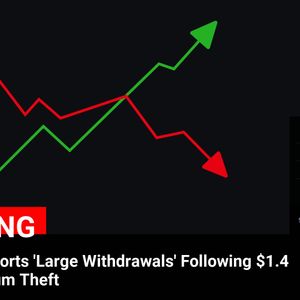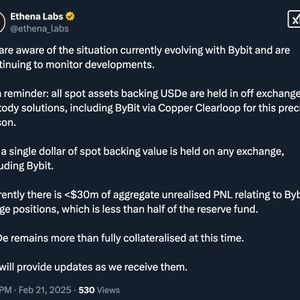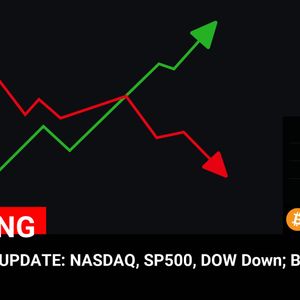Ju pointed out that Bitcoin’s long-term trend is still bullish, as key support levels remain strong, particularly around $89,000 and $85,000. On-chain data also indicates that a major breakout is imminent, very similar to August of 2023’s volatility patterns. Meanwhile, industry experts, including Samson Mow, raised some concerns about potential market manipulation, as Bitcoin’s price has been trading in a very tight range despite strong institutional demand. Even though there is short-term uncertainty, analysts expect BTC to reach between $160,000 and $180,000 in 2025. BTC’s Bull Cycle Is Not Over Bitcoin's price could experience a big dip to $77,000 without actually jeopardizing its ongoing bull market, according to CryptoQuant CEO Ki Young Ju . In a series of posts on X, Ki argued that a 30% decline from Bitcoin’s all-time high will still align with historical trends. This means that the bull cycle is still intact despite recent price stagnation. He also believes that while Bitcoin struggled to reclaim the $100,000 mark over the past few weeks, the overall trend remains bullish, and higher price levels are still likely to materialize throughout 2025. (Source: X ) Ki dismissed concerns about an imminent bear market by explaining that Bitcoin’s price range could be broad, but historical patterns suggest that even with a big pullback, the overall uptrend would continue. A drop to $77,000 will still keep BTC/USD above its previous cycle’s all-time high, making it a crucial support level for traders looking to establish a firm market floor. He specifically pointed to aggregate cost bases of key investor groups, and noticed that US spot Bitcoin ETF investors currently have an average buy-in at $89,000, which is a level that served as support since November. Similarly, new Bitcoin whales have an identical entry point, adding to its importance as a potential reversal zone in the event of a market downturn. While ETF investors maintained an elevated cost basis, traders on Binance have a much lower aggregate breakeven point at $59,000. Below that, Bitcoin miners will begin to suffer losses if BTC falls below $57,000, which is a threshold that historically signaled the start of bear markets in previous downturns like in May of 2022, March of 2020, and November of 2018. According to Ki, staying above these levels is critical for Bitcoin’s bullish trajectory. Other analysis from CryptoQuant also cemented the expectation of more price appreciation this cycle. Analyst Timo Oinonen described Bitcoin’s post-halving rally as “unfinished,” and suggested that the gains seen since last April’s block subsidy halving event are still modest at just 60%. (Source: CryptoQuant ) Historically, Bitcoin saw impressive price increases in the quarters after halvings, and Oinonen expects a pattern similar to previous cycles, where a potential market dip in May is followed by a quiet summer and a resurgence in the fourth quarter. He pointed out that positive seasonality in Q4 was a recurring trend in years like 2013, 2016, 2017, 2020, 2021, 2023, and 2024. This makes a deeper correction unlikely in the near term. Despite the uncertainty in Bitcoin’s price action, historical trends and key support levels suggest that the broader market is still in a bullish phase. While short-term fluctuations may test investor sentiment, long-term holders and institutions seem very confident in Bitcoin’s fundamental strength. BTC Price Action Also Mirrors August 2023 Bitcoin's price action is showing signs of a shakeup as on-chain analytics suggest a return to volatility very similar to August of 2023. CryptoQuant research also indicates that BTC/USD is “ready” for a major move as extreme levels of choppiness indicate the need for a breakout. (Source: CryptoQuant ) CryptoQuant contributor Percival compared the current market conditions to those seen in mid-2023 when Bitcoin’s Choppiness Index signaled an impending surge in volatility. At that time, Bitcoin experienced a sharp drop before starting a multi-month uptrend. The latest readings from the index, which currently stand at 62 on the daily chart and 72 on the weekly, indicate that Bitcoin is overdue for a decisive move in either direction. The 90-day range that BTC has been confined to saw fluctuations of around 16% between its highs and lows, which supports the expectation of an upcoming breakout. Percival mentioned that before Bitcoin’s rally in 2023, the market first cleared out traders holding positions that were built in a period of low volatility. This kind of liquidity grab could be setting up again and create conditions for a quick move before Bitcoin resumes its broader trend. Over the past six months, the Choppiness Index showed multiple peaks. In December, Percival successfully used the index to predict a cooling-off period for Bitcoin when it approached the $110,000 level. BTC’s price action over the past month (Source: CoinMarketCap ) Looking at potential downside targets if Bitcoin follows the same path as last year, Percival pointed to the short-term holder cost basis at $92,000 as a crucial level of interest. If Bitcoin drops below that threshold, the 200-day exponential moving average at $85,000 may act as a stronger support zone. He warned investors that false breakouts are common in bull markets, as the market often flushes out traders betting on premature breakouts before returning to its expected trajectory. The fact that these historical comparisons align means the likelihood of Bitcoin experiencing a sharp price movement before continuing its uptrend certainly seems to be increasing. Is Bitcoin’s Price Being Suppressed? Bitcoin’s price action is also causing concerns of potential market manipulation because it keeps trading in a tight range despite institutional inflows. In fact, BTC has been oscillating between $92,400 and $106,500 since Dec. 18, 2024, with only a brief breakout to $109,000 after US President Donald Trump’s inauguration on Jan. 20. Samson Mow, CEO of Jan3 and founder of Pixelmatic, suggested that Bitcoin’s current stagnation may be the result of price suppression. At Consensus Hong Kong 2025 , Mow pointed out that the asset’s steady, sideways movement looks manufactured rather than a natural consolidation. Mow at Consensus 2025 Despite this price stability, industry analysts are still bullish on Bitcoin’s trajectory for 2025, with price targets ranging between $160,000 and $180,000. The growing inflows into US spot Bitcoin ETFs and continued institutional buying, including Michael Saylor’s Strategy accumulating more Bitcoin than what is mined daily, suggest that demand for BTC is still very strong. However, Mow suggested that if Bitcoin’s price is not responding to these bullish factors, then major selling must be taking place. Previous years saw intense selling pressure from bankruptcies and restructuring events, but that phase is mostly in the past. With structural sellers now diminished, Bitcoin’s price suppression is raising more and more speculation about hidden market forces influencing its short-term movements.




















